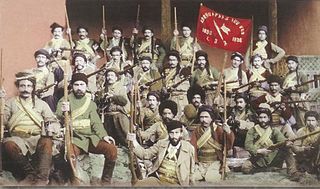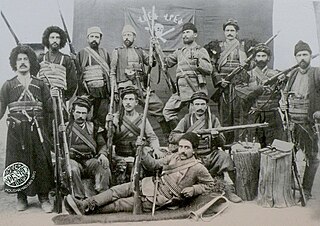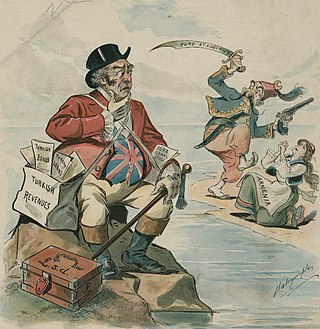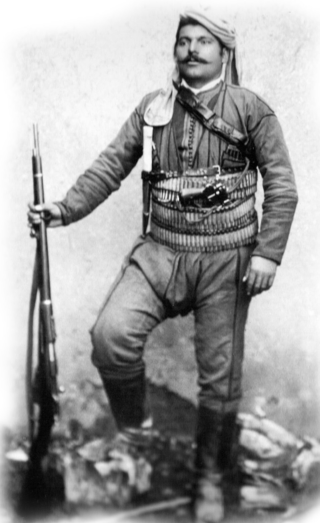Related Research Articles

Erzurum is a city in eastern Anatolia, Turkey. It is the largest city and capital of Erzurum Province and is 1,900 meters above sea level. Erzurum had a population of 367,250 in 2010. It is the site of ancient Theodosiopolis.

The Hamidian massacres also called the Armenian massacres, were massacres of Armenians in the Ottoman Empire in the mid-1890s. Estimated casualties ranged from 100,000 to 300,000, resulting in 50,000 orphaned children. The massacres are named after Sultan Abdul Hamid II, who, in his efforts to maintain the imperial domain of the declining Ottoman Empire, reasserted pan-Islamism as a state ideology. Although the massacres were aimed mainly at the Armenians, in some cases they turned into indiscriminate anti-Christian pogroms, including the Diyarbekir massacres, where, at least according to one contemporary source, up to 25,000 Assyrians were also killed.

The First Republic of Armenia, officially known at the time of its existence as the Republic of Armenia, was an independent Armenian state that existed from May 1918 to 2 December 1920 in the Armenian-populated territories of the former Russian Empire known as Eastern or Russian Armenia. The republic was established in May 1918, with its capital in the city of Yerevan, after the dissolution of the short-lived Transcaucasian Federation. It was the first Armenian state since the Middle Ages.

Russian Armenia is the period of Armenian history under Russian rule from 1828, when Eastern Armenia became part of the Russian Empire following Qajar Iran's loss in the Russo-Persian War (1826–1828) and the subsequent ceding of its territories that included Eastern Armenia per the out coming Treaty of Turkmenchay of 1828.

The Turkish–Armenian War, known in Turkey as the Eastern Front of the Turkish War of Independence, was a conflict between the First Republic of Armenia and the Turkish National Movement following the collapse of the Treaty of Sèvres in 1920. After the provisional government of Ahmet Tevfik Pasha failed to win support for ratification of the treaty, remnants of the Ottoman Army's XV Corps under the command of Kâzım Karabekir attacked Armenian forces controlling the area surrounding Kars, eventually recapturing most of the territory in the South Caucasus that had been part of the Ottoman Empire prior to the Russo-Turkish War (1877–1878) and was subsequently ceded by Soviet Russia as part of the Treaty of Brest-Litovsk.

Wilsonian Armenia was the unimplemented boundary configuration of the First Republic of Armenia in the Treaty of Sèvres, as drawn by U.S. President Woodrow Wilson's Department of State. The Treaty of Sèvres was a peace treaty that had been drafted and signed between the Western Allied Powers and the defeated government of the Ottoman Empire in August 1920, but it was never ratified and was subsequently superseded by the Treaty of Lausanne. The proposed boundaries of Wilsonian Armenia incorporated portions of the Ottoman vilayets of Erzurum, Bitlis, Van, and Trabzon, which had Armenian populations of varying sizes. The inclusion of portions of Trabzon Vilayet was intended to provide the First Republic of Armenia with an outlet to the Black Sea at the port of Trabzon. A proposed Republic of Pontus was discussed at the Paris Peace Conference of 1919, but the Greek government of Eleftherios Venizelos feared the precarious position of such a state, so a portion of it was instead included in the proposed state of Wilsonian Armenia.

Hovhannes Kajaznuni or Katchaznouni was an Armenian architect and politician who served as the first prime minister of the First Republic of Armenia from 6 June 1918 to 7 August 1919. He was a member of the Armenian Revolutionary Federation.

The Armenian national awakening paralleled the rise of nationalism among other non-Turkish ethnic groups during the late Ottoman Empire. Ottoman statesmen sought to counter Armenian nationalism during the Tanzimat era, initially through the promotion of Ottomanism and later by transforming the empire into a constitutional monarchy during the First Constitutional Era. However, the reorganization of the millets—the legal courts for confessional communities—exacerbated the issue of dualism within the Ottoman state.

Fedayi, also known as the Armenian irregular units, Armenian militia, or Armenian Hayduks were Armenian civilians who voluntarily left their families to form self-defense units and irregular armed-bands in reaction to the mass murder of Armenians and the pillage of Armenian villages by criminals, Turkish and Kurdish gangs, Ottoman forces, and Hamidian guards during the reign of Ottoman Sultan Abdul Hamid II in late-19th and early-20th centuries, known as the Hamidian massacres. Their ultimate goal was always to gain Armenian autonomy or independence - depending on their ideology and the degree of oppression visited on Armenians.

The Khanasor Expedition was a punitive raid launched by Armenian fedayis against the Kurdish Mazrik tribe on July 25, 1897. In 1896, in the aftermath of the Defense of Van, the Kurdish Mazrik tribe had ambushed and slaughtered many of the Armenian defenders of Van as they were retreating into Persia. The Armenian Revolutionary Federation decided to retaliate for that atrocity, resulting in the Khanasor Expedition.
The Armenian national movement included social, cultural, but primarily political and military movements that reached their height during World War I and the following years, initially seeking improved status for Armenians in the Ottoman and Russian Empires but eventually attempting to achieve an Armenian state.
The Shabin-Karahisar uprising was a resistance effort by the Armenian militia of the Hunchaks of the Giresun Province against Ottoman troops during the Armenian genocide. They had resisted the Ottoman onslaught for the duration of a month. The Armenians had positioned themselves in a fort right outside the town where about 250 men fought off Turkish soldiers.

The Armenian question was the debate following the Congress of Berlin in 1878 as to how the Armenians in the Ottoman Empire should be treated. The term became commonplace among diplomatic circles and in the popular press. In specific terms, the Armenian question refers to the protection and the freedoms of Armenians from their neighboring communities. The Armenian question explains the 40 years of Armenian–Ottoman history in the context of English, German, and Russian politics between 1877 and 1914. In 1915, the leadership of the Committee of Union and Progress, which controlled the Ottoman government, decided to end the Armenian question permanently by killing and expelling most Armenians from the empire, in the Armenian genocide.

Richard Gable Hovannisian was an American historian and professor at the University of California, Los Angeles. He is known mainly for his four-volume history of the First Republic of Armenia, and for his advocacy of Armenian Genocide recognition.
The Zeitun rebellion or Second Zeitun Resistance took place in the winter of 1895–1896, during the Hamidian massacres, when the Armenians of Zeitun, fearing the prospect of massacre, took up arms to defend themselves from Ottoman troops.

Kevork Ghazarian, commonly known as Kevork Chavush or Gevorg Chaush, was an Armenian fedayee leader in the Ottoman Empire and a member of the Armenian Revolutionary Federation.

Murad of Sebastia was a well-known Armenian fedayee during the Armenian national liberation movement in the Ottoman Empire. He was born in the Armenian village of Govdun (Կովտուն), about 20 km east of the town of Sivas to a poor rural family that had recently moved to the village. After working as a shepherd and farm labourer during his childhood, he moved as a teenager to Constantinople, where he worked for meagre earnings as a carrier. He joined the Social Democrat Hunchakian Party and, in the 1890s, participated in Armenian demonstrations protesting against the second-class treatment of Armenians within the Ottoman Empire.

Ruben Ter Minasian was an Armenian politician and revolutionary of the Armenian Revolutionary Federation (ARF) who played an important role in the Armenian national liberation movement and later in the First Republic of Armenia.
Bibliography of the Armenian genocide is a list of books about the Armenian genocide:
Anarchism in Armenia emerged as part of the Armenian national liberation movement, with its roots in various heretical Christian sects that practiced in the region. It took on an organized form with the establishment of the Armenian Revolutionary Federation in 1890, before being suppressed by the various empires and authoritarian regimes that ruled over Armenia during the 20th century. It eventually re-emerged in the 21st century, as part of the anti-establishment movement that spread throughout the country in the wake of its independence.
References
- ↑ Hovanissian, Richard G. "The Armenian Question in the Ottoman Empire, 1876-1914" in The Armenian People From Ancient to Modern Times, Volume II: Foreign Dominion to Statehood: The Fifteenth Century to the Twentieth Century. Ed. Richard G. Hovannisian. New York: St. Martin's Press, 1997, p. 212-213. ISBN 0-312-10168-6.
- ↑ Libaridian Gerard. Modern Armenia: People, Nation, State. New Brunswick, NJ: Transaction Publishers, 2004, pp. 81-82.
- ↑ Peroomian, Rubina. Literary Responses to Catastrophe: A Comparison of the Armenian and the Jewish Experience. Atlanta: Scholars Press, 1993, p. 72.
- ↑ Peroomian, Rubina. "A Call Sounded from the Armenian Mountains of Erzerum" in Armenian Karin/Erzerum. UCLA Armenian History and Culture Series: Historic Armenian Cities and Provinces, 4. Ed. Richard G. Hovannisian. Costa Mesa, CA: Mazda Publishers, 2003, pp. 189-222.